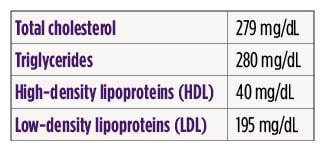If you’re preparing for the United States Medical Licensing Examination® (USMLE®) Step 3 exam, you might want to know which questions are most often missed by test-prep takers. Check out this example from Kaplan Medical, and read an expert explanation of the answer. Also check out all posts in this series.
This month’s stumper
A 59-year-old man in generally good health presents for his yearly health exam. He has no complaints. His family history is significant for acute myocardial infarction, of which his father died at age 38, and angina, which his brother has. He does not smoke and drinks alcohol socially. His blood pressure is 129/84 mm Hg. The remainder of the physical examination is unremarkable. An electrocardiogram is normal. A fasting cholesterol profile shows:
Which of the following is the most appropriate next step in management of this patient?
A. Coronary arteriogram followed by coronary angioplasty.
B. Metoprolol therapy and follow-up blood pressure in three months.
C. No treatment is required at this time.
D. Simvastatin therapy and diet, plus exercise modification therapy.
E. Trial of diet and exercise modification therapy and then a follow-up lipid panel.
The correct answer is D.
Kaplan Medical explains why
This patient has multiple cardiac risk factors, which include being older than 45 and a positive family history. Since his LDL cholesterol level is greater than 160 mg/dL and he has two risk factors, he should be started on drug, diet and exercise-modification therapy.
Why the other answers are wrong
Choice A: The patient is completely asymptomatic, so arteriogram and angioplasty are not indicated.
Choice B: Metoprolol therapy and follow-up blood pressure in three months is incorrect because his blood pressure is still in the normal range.
Choice C: No treatment is not an appropriate recommendation, given the patient's risk factors. Moreover, this is not a normal cholesterol profile.
Choice E: Trial of diet and exercise modification therapy with follow-up lipid panel is inappropriate, as patient should also have drug therapy. He has a family history of coronary disease, defined as a male relative with coronary disease at age 55 or younger or a female relative at age 65 or younger.
Tips to remember
Start restricted diet Start lipid-lowering medications
0-1 risk factors >160 mg/dL >190 mg/dL
2+ risk factors >130 mg/dL >160 mg/dL
CAD or equivalent >100 mg/dL >100-130 mg/dL
For more prep questions on USMLE Steps 1, 2 and 3, view other posts in this series.




